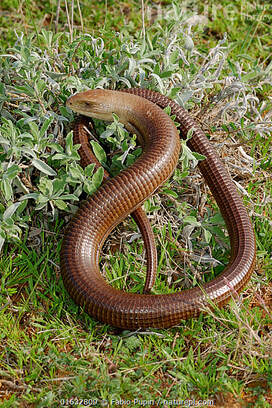Legless Lizard (Pseudopus apodus)

Physical Description: The European Legless Lizard can grow to length of 4 feet but 2/3 of the length is tail. They have a shovel-shaped snout, smooth shiny scales, and a blunt tail. They have a tan coloration with pale head and underbelly. They have very tiny remnants of the hind limbs that are visible as small nubbins on either side of the cloaca. European Legless Lizards have a distinctive fold of skin down each side called a lateral groove. European Legless Lizards are burrowing reptiles. They live in the underbrush, burrow through soft substrates, and eat invertebrates and small vertebrates they encounter in these habitats. They are most active during the morning and evening when they forage beneath the surface of loose soil or leaf litter that has been warmed by the sun. They are very sensitive to changes in temperature. In the summer, they seek cooler environs when it gets too hot, and they hibernate during the winter when freezing can be severe.
Although they are often confused with snakes, they cannot coil up like snakes, and differ from snakes in that they have ear holes, eyelids, and ventral scales and snakes do not.
Habitat: The European Legless Lizard prefers light woods, dry open areas, grasslands, scrubby vegetation, and rocky outcrops. Although it favors dry areas, it will come out after rain to hunt for snails and slugs.
Range: The European Legless Lizard is native to far eastern Europe and western Eurasia.
Diet: They are carnivores. They eat snails, slugs, insects, eggs and occasionally very small mammals and birds.
Lifespan: They live 30 years in the wild and up to 50 in human care.
Social Structure: European Legless Lizards mate once a year when they come out of hibernation. A female will lay about 8 eggs 10 weeks after mating. The eggs are often hidden in a crevice and guarded by the female. After about 50 days the young hatch and are 6 inches long. The young are independent upon hatching.
Status: Least Concern1
Other: European Legless Lizards are also called European Glass Lizards or Scheltopusik (a Slavic word meaning “yellow belly”). They get the name “Glass Lizards” from their tails, which can not only be dropped but can also break into several smaller pieces, like shattered glass.
1 https://www.iucnredlist.org/species/157263/745759
Although they are often confused with snakes, they cannot coil up like snakes, and differ from snakes in that they have ear holes, eyelids, and ventral scales and snakes do not.
Habitat: The European Legless Lizard prefers light woods, dry open areas, grasslands, scrubby vegetation, and rocky outcrops. Although it favors dry areas, it will come out after rain to hunt for snails and slugs.
Range: The European Legless Lizard is native to far eastern Europe and western Eurasia.
Diet: They are carnivores. They eat snails, slugs, insects, eggs and occasionally very small mammals and birds.
Lifespan: They live 30 years in the wild and up to 50 in human care.
Social Structure: European Legless Lizards mate once a year when they come out of hibernation. A female will lay about 8 eggs 10 weeks after mating. The eggs are often hidden in a crevice and guarded by the female. After about 50 days the young hatch and are 6 inches long. The young are independent upon hatching.
Status: Least Concern1
Other: European Legless Lizards are also called European Glass Lizards or Scheltopusik (a Slavic word meaning “yellow belly”). They get the name “Glass Lizards” from their tails, which can not only be dropped but can also break into several smaller pieces, like shattered glass.
1 https://www.iucnredlist.org/species/157263/745759






